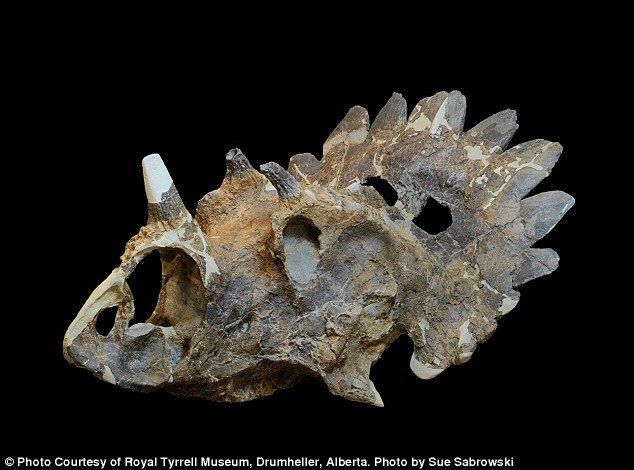
The remains of a dinosaur nicknamed ‘Hellboy’ has been identified in Alberta, Canada.
The fossils were discovered a decade ago by Peter Hews who stumbled across them sticking out of a cliff along the Oldman River in south eastern Alberta, Canada.
The dinosaur has comically small horns and is a relative of the famous Triceratops. It has been named Regaliceratops peterhewsi because of its shield like frill around the back of its skull and its distinctive facial horns.

BYPASS THE CENSORS
Sign up to get unfiltered news delivered straight to your inbox.
You can unsubscribe any time. By subscribing you agree to our Terms of Use
The small horns resemble those of the comic book character ‘Hellboy’ played by Ron Perlman in the movie of the same name.
Scientists believe the discovered bones of a nearly intact skull belong to ‘Hellboy’ who roamed the earth some 70 million years ago, probably in the palaeoenvironment of the Late Cretaceous period (the golden age of the dinosaurs), around Alberta, Canada.
The Daily Mail reports:
The specimen – a close relative to the familiar Triceratops – has been nicknamed ‘Hellboy’ because two of its small horns resemble those of the comic book character.
Its official name is Regaliceratops peterhewsi, which refers to the dinosaur’s crown-like frill around its face and the name of the man who found the fossils.
‘The specimen comes from a geographic region of Alberta where we have not found horned dinosaurs before, so from the onset we knew it was important,’ Dr Caleb Brown, of the Royal Tyrrell Museum of Palaeontology in Canada said.
‘However, it was not until the specimen was being slowly prepared from the rocks in the laboratory that the full anatomy was uncovered, and the bizarre suite of characters revealed.
‘Once it was prepared it was obviously a new species, and an unexpected one at that.
Many horned-dinosaur researchers who visited the museum did a double take when they first saw it in the laboratory.’
The dinosaur is distinctive because of the size and shape of its facial horns and the shield-like frill at the back of the skull.
In some ways, the new species resembles Triceratops, except that its nose horn is taller and the two horns over its eyes are ‘almost comically small.’
But the new dinosaur’s most distinctive feature is the frill, including what Dr Brown describes as a halo of large, pentagonal plates radiating outward, as well as a central spike.
He said: ‘The combined result looks like a crown.’
Dr Brown added the uniqueness of the specimen was so obvious he could tell it was a new species from 100 yards away.
The team, including co-author Donald Henderson, said the specimen will help experts piece together the evolution of dinosaurs’ horned ornamentation.
Horned dinosaurs fall into two categories – the Chasmosaurines, such as Triceratops which have a small horn over the nose and larger horns over the eyes, as well as a long frill – and the Centrosaurines, which are characterised by a large horn over the nose, small horns over the eyes, and a short frill.
Dr Brown said: ‘This new species is a Chasmosaurine, but it has ornamentation more similar to Centrosaurines.
‘It also comes from a time period following the extinction of the Centrosaurines.’
Taken together, he said R. peterhewsi demonstrates the first example of evolutionary convergence in horned dinosaurs, meaning that these two groups independently evolved similar features.
And the researchers hope to uncover more R. peterhewsi specimens.
They also plan to reconstruct the skull digitally, as although intact, the fossil has been deformed after 70 million years in the Rocky Mountain foothills.
‘This discovery suggests that there are likely more horned dinosaurs out there that we just have not found yet, so we will also be looking for other new species,’ Dr Brown added.
LetsJoin YouTube video:
Edmondo Burr
CEO
Assistant Editor
Latest posts by Edmondo Burr (see all)
- Police Arrest Suspect In Supermarket Baby Food Poisoning - October 1, 2017
- Seoul Secures Data From Electromagnetic Interference By N Korea - September 30, 2017
- The ‘World’s First Internet War’ Has Begun: Julian Assange - September 30, 2017


Be the first to comment